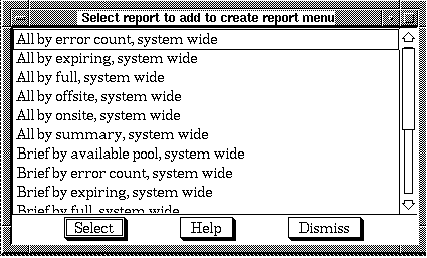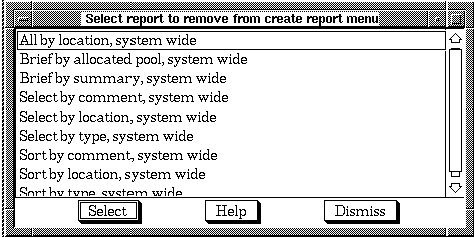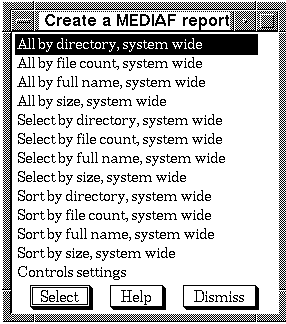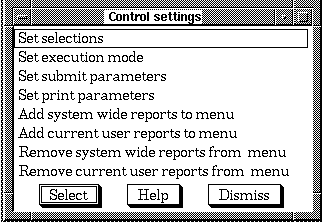| Previous | Contents | Index |
In order to add system wide or current user reports to the Create a media report menu, choose Add system wide reports or Add current user reports to menu from the Control settings menu. A menu listing of the reports not already added to the menu will appear. Choose the desired report and it will appear the next time the program is invoked.

In order to remove system wide or current user reports from the Create a media report menu, choose Remove system wide reports or Remove current user reports from menu from the Control settings menu.
A menu listing of the reports already added to the menu will appear.
Figure 7-20 Select report to remove

Choose the desired report and it will not appear the next time the
program is invoked.
7.16 Media Contents REPORTS
To produce reports about media contents, select Media Contents REPORTS from the Media Library functions menu.

Selecting any menu item from the first menu item up to the
Control settings menu item will produce a report.
Reports can be added or removed from this menu by user selections
within the Control settings menu item. For information
on the creation of reports, see <REFERENCE>(date_rep), "Database
reporting".
7.16.1 Control settings
To control the selection of data to be reported and parameters related to producing the report, select Control settings from the Create a MEDIAF Report menu.

To control the selection of data to be reported, select Set
selections from the Control Settings menu.
Refer to Section 7.15.2.1 for a description of the procedure involved in
setting the selection data.
7.16.1.2 Set execution mode
To control the output of the report, select Set execution
mode from the Control Settings menu. For a
detailed description of the Set execution mode
procedure, see Section 7.15.2.2.
7.16.1.3 Set submit parameters
To set the submit parameters for the reports, select Set submit
parameters from the Control Settings menu.
For a complete description of the Set submit parameter
operation, see Section 7.15.2.3.
7.16.1.4 Set print parameters
To set the print parameters for the reports, select Set print
parameters from the Control Settings menu.
7.16.1.5 Add reports to menu
In order to add system wide or current user reports to the Create a media report menu, choose Add system wide reports or Add current user reports to menu from the Control settings menu. A menu listing of the reports not already added to the menu will appear.

Choose the desired report and it will appear the next time the menu
option "MEDIA Contents Reports" is selected.
7.16.1.6 Remove reports from menu
In order to remove system wide or current user reports from the Create a media report menu, choose Remove system wide reports or Remove current user reports from menu from the Control settings menu.
A menu listing of the reports already added to the menu will appear.

Choose the desired report and it will not appear the next time the menu
option "MEDIAF Contents Reports" is selected.
7.17 MCL Report types
MEDIA features a wide variety of report types which provide
information on many aspects of the MEDIA database. The reports
are divided into two distinct categories: contents and database
reports. Each of these categories are further divided into current user
and system wide reports. Each will be explained in the following lists.
7.17.1 Database report types
Database reports provide information on the MEDIA database.
This specifically refers to database entries such as location, type or
expiration date of the specified media.
7.17.1.1 System wide database reports
If the user chooses to submit a system wide report, all media in the database that are accessible by the user are eligible for inclusion. The report types are:
| All, by location | All, by error count | Brief, by full |
| Brief, by allocated pool | All, by expiring | Brief, by location |
| Brief, by summary | All, by full | Brief, by offsite |
| Select, by summary | All, by offsite | Brief, by onsite |
| Select, by location | All, by onsite | Brief, by pool count |
| Select, by type | All, by summary | Brief, by release pool |
| Sort, by comment | Brief, by available pool | Brief, by user count |
| Sort, by location | Brief, by error count | Brief, by user |
| Sort, by type | Brief, by expiring |
If the user chooses to submit a current user report, only media in the database that are owned by the current user are eligible for inclusion. The report types are:
| All, by error count | All, by user | Brief, by summary |
| All, by expiring | Brief, by error count | Select, by comment |
| All, by full | Brief, by expiring | Select, by location |
| All, by location | Brief, by full | Select, by type |
| All, by offsite | Brief, by location | Select, by comment |
| All, by onsite | Brief, by offsite | Select, by location |
| All, by summary | Brief, by onsite |
Contents reports provide information on the files and directories that
are contained on the media in the database. Typical information will be
file names, directories and file counts.
7.17.2.1 System wide contents reports
If the user chooses to submit a system wide report, all media in the database that are accessible by the user are eligible for inclusion. The report types are:
| All, by directory | Select, by directory | Sort, by directory |
| All, by file count | Select, by file count | Sort, by file count |
| All, by full name | Select, by full name | Sort, by full name |
| All, by size | Select, by size | Sort, by size |
If the user chooses to submit a current user report, only media in the database that are owned by the current user are eligible for inclusion. The report types are:
| All, by directory | Select, by directory | Sort, by directory |
| All, by file count | Select, by file count | Sort, by file count |
| All, by full name | Select, by full name | Sort, by full name |
| All, by size | Select, by size | Sort, by size |
The basic approach to using BCKMGR is to create a new job (or select a pre-existing one), apply your desired options and submit it. As you will see, there are several other options including "Full disk recovery" and media assignment options, but job definition and submission are the principle functions.
Using BCKMGR, you can easily designate the media you are using for a backup, the job type, the number of media required and the priority of the job. You can set the submit options and the access controls. You can decide whether you want a record of your backup to be put in the VAULT database. Once you have all the settings defined for a job, it can be submitted at regular intervals, on a daily or weekly basis or any time span you designate.
One of the key attributes is the backup mode number. The backup mode controls how the backup operation is performed. Several predefined modes are provided with the system. Others can easily be added by the user as needed. Table 8-1 lists the various predefined mode numbers.
| Standard | Scratch | |||
|---|---|---|---|---|
| Backup Type | Incremental | Full | Incremental | Full |
| On-line | 2 | 3 | 4 | 5 |
| Appending | 13 | 14 | 15 | 16 |
| Remote VMS | 9 | 10 | 11 | 12 |
| Remote PC | 17 | 18 | 19 | 20 |
| Remote NFS | 21 | 22 | 23 | 24 |
| Agent NT | 25 | 25 | 25 | 25 |
| Backup Type | Incremental | Full | After Image Journal | |
| RDB | 6 | 7 | 8 | |
The backup types are summarized in the below list.
OPERATORS or MANAGERS handling backups who also have SCHEDULE7 installed on their system can perform more sophisticated and event dependent jobs. BCKMGR will automatically detect if SCHEDULE is installed on your system and utilize it's advanced scheduling capabilities in performing your backups.
1 Scratch processing is now available on both VAX and ALPHA platforms.2 DeviceShare is a trademark of Advanced Systems Concepts, Inc. Check with your MEDIA distributor for availability.3 LANutil is a trademark of Vector Networks Limited. Check with your MEDIA distributor for availability.4 TCPware from Process Software Corp.5 MultiNet from TGV Software Inc.6 TCP/IP Services from Digital Equipment Corp.7 The SCHEDULE automated backup system is available as a separate product. |
| Previous | Next | Contents | Index |